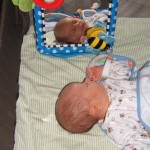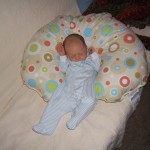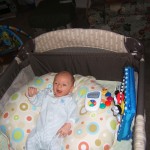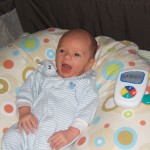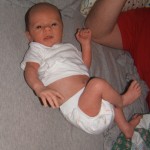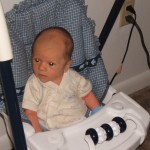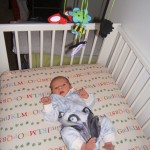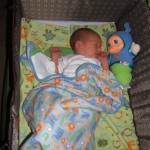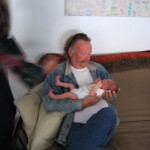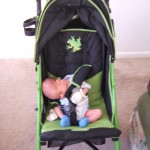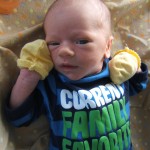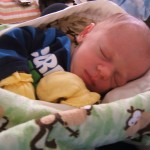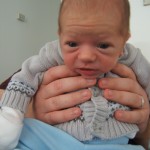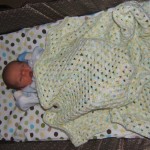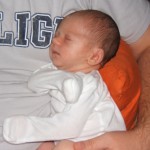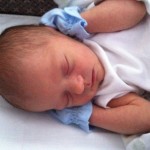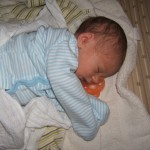I think we planned to have Ben sleep in a crib – we did get one for a reason. But since his birth, even while we were still in the hospital, he won’t sleep anywhere except on or next to someone, usually me. You put him down and 30 seconds to 5 minutes later, he’s screaming his head off. I gave in quite early on, sacrificing ample room on the futon or in the bed for a relatively good night’s sleep. Him sleeping with me allows me to not have to get up when he cries, easy access for feeding, and we both sleep almost through the night.
Of course, there’s controversy about co-sleeping, and I started to get concerned that he’d never sleep on his own. After some Googling I feel a lot better about it. I love this article from AskDrSears.com:
1. Babies sleep betterSleepsharing babies usually go to sleep and stay asleep better. Being parented to sleep at the breast of mother or in the arms of father creates a healthy go-to-sleep attitude. Baby learns that going to sleep is a pleasant state to enter (one of our goals of nighttime parenting). Babies stay asleep better. Put yourself in the sleep pattern of baby. As baby passes from deep sleep into light sleep, he enters a vulnerable period for nightwaking, a transition state that may occur as often as every hour and from which it is difficult for baby to resettle on his own into a deep sleep. You are a familiar attachment person whom baby can touch, smell, and hear. Your presence conveys an “It’s OK to go back to sleep” message. Feeling no worry, baby peacefully drifts through this vulnerable period of nightwaking and reenters deep sleep. If baby does awaken, she is sometimes able to resettle herself because you are right there. A familiar touch, perhaps a few minutes’ feed, and you comfort baby back into deep sleep without either member of the sleep-sharing pair fully awakening.
Many babies need help going back to sleep because of a developmental quirk called object or person permanence. When something or someone is out of sight, it is out of mind. Most babies less than a year old do not have the ability to think of mother as existing somewhere else. When babies awaken alone in a crib, they become frightened and often unable to resettle back into deep sleep. Because of this separation anxiety, they learn that sleep is a fearful state to remain in (not one of our goals of nighttime parenting).
2. Mothers sleep betterMany mothers and infants are able to achieve nighttime harmony: babies and mothers get their sleep cycles in sync with one another.
Martha notes: “I would automatically awaken seconds before my baby would. When the baby started to squirm, I would lay on a comforting hand and she would drift back to sleep. Sometimes I did this automatically and I didn’t even wake up.”
Contrast sleepsharing with the crib and nursery scene. The separate sleeper awakens – alone and behind bars. He is out of touch. He first squirms and whimpers. Still out of touch. Separation anxiety sets in, baby becomes scared, and the cry escalates into an all-out wail or plea for help. This piercing cry awakens even the most long distance mother, who jumps up (sometimes out of the state of deep sleep, which is what leads to most nighttime exhaustion), and staggers reluctantly down the hall. By the time mother reaches the baby, baby is wide awake and upset, mother is wide awake and upset, and the comforting that follows becomes a reluctant duty rather than an automatic nurturant response. It takes longer to resettle an upset solo sleeper than it does a half-asleep baby who is sleeping within arm’s reach of mother. Once baby does fall asleep, mother is still wide-awake and too upset to resettle easily. If, however, the baby is sleeping next to mother and they have their sleep cycles in sync, most mothers and babies can quickly resettle without either member of the sleepsharing pair fully awakening. Being awakened suddenly and completely from a state of deep sleep to attend to a hungry or frightened baby is what leads to sleep-deprived parents and fearful babies.
3. Breastfeeding is easierMost veteran breastfeeding mothers have, for survival, learned that sharing sleep makes breastfeeding easier. Breastfeeding mothers find it easier than bottlefeeding mothers to get their sleep cycles in sync with their babies. They often wake up just before the babies awaken for a feeding. By being there and anticipating the feeding, mother can breastfeed baby back to a deep sleep before baby (and often mother) fully awakens. A mother who had achieved nighttime-nursing harmony with her baby shared the following story with us:
“About thirty seconds before my baby wakes up for a feeding, my sleep seems to lighten and I almost wake up. By being able to anticipate his feeding, I usually can start breastfeeding him just as he begins to squirm and reach for the nipple. Getting him to suck immediately keeps him from fully waking up, and then we both drift back into a deep sleep right after feeding.”
Mothers who experience daytime breastfeeding difficulties report that breastfeeding becomes easier when they sleep next to their babies at night and lie down with baby and nap nurse during the day. We believe baby senses that mother is more relaxed, and her milk-producing hormones work better when she is relaxed or sleeping.
4. It’s contemporary parentingSleepsharing is even more relevant in today’s busy lifestyles. As more and more mothers, out of necessity, are separated from their baby during the day, sleeping with their baby at night allows them to reconnect and make up for missed touch time during the day. As a nighttime perk, the relaxing hormones that are produced in response to baby nursing relax a mother and help her wind down from the tension of a busy day’s work.
5. Babies thrive betterOver the past thirty years of observing sleepsharing families in our pediatric practice, we have noticed one medical benefit that stands out; these babies thrive. “Thriving” means not only getting bigger, but also growing to your full potential, emotionally, physically, and intellectually. Perhaps it’s the extra touch that stimulates development, or perhaps the extra feedings (yes, sleepsharing infants breastfeed more often than solo sleepers).
6. Parents and infants become more connectedRemember that becoming connected is the basis of parenting, and one of your early goals of parenting. In our office, we keep a file entitled “Kids Who Turned Out Well, What Their Parents Did.” We have noticed that infants who sleep with their parents (some or all of the time during those early formative years) not only thrive better, but infants and parents are more connected.
7. Reduces the risk of SIDSNew research is showing what parents the world over have long suspected: infants who sleep safely nestled next to parents are less likely to succumb to the tragedy of SIDS. Yet, because SIDS is so rare (.5 to 1 case per 1,000 infants), this worry should not be a reason to sleep with your baby. (For in depth information on the science of sleepsharing and the experiments showing how sleep benefits a baby’s nighttime physiology. (See SIDS) Co-sleeping does not always work and some parents simply do not want to sleep with their baby. Sleepsharing is an optional attachment tool. You are not bad parents if you don’t sleep with your baby. Try it. If it’s working and you enjoy it, continue. If not, try other sleeping arrangements (an alternative is the sidecar arrangement: place a crib or co-sleeper adjacent to your bed).
New parents often worry that their child will get so used to sleeping with them that he may never want to leave their bed. Yes, if you’re used to sleeping first-class, you are reluctant to be downgraded. Like weaning from the breast, infants do wean from your bed (usually sometime around two years of age). Keep in mind that sleepsharing may be the arrangement that is designed for the safety and security of babies. The time in your arms, at your breast, and in your bed is a very short time in the total life of your child, yet the memories of love and availability last a lifetime.

